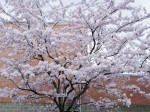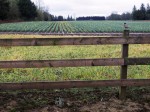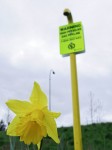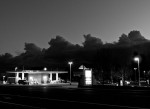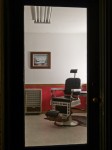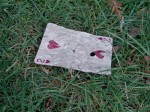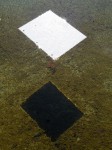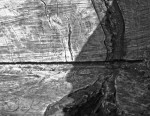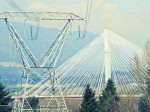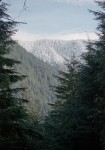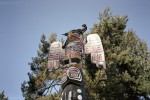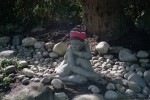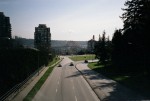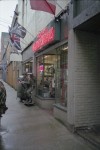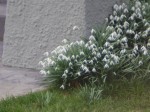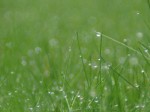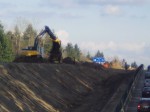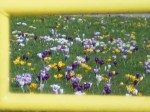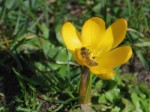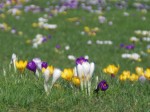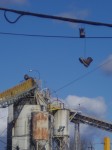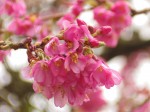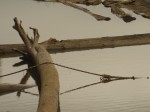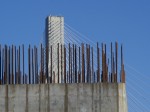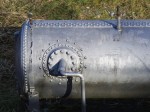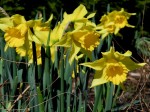Apr
8
2013

Pentax has released a new firmware update for the Q PENTAX Firmware Update Software for Q which dramatically improves the autofocus, especially in low light. It wasn’t that the Q was bad before but there is a noticeable speed increase. At the moment though the only lens I own with autofocus is the standard prime. A quick test in very low light shows that the camera is able to focus at 3200 ISO f1.9 and 1/4sec which is about -1EV which is very good and approaching DSLR levels.
I often take the Pentax Q with me when I’m out simply because it outperforms its size. What I mean by that is for the small amount of space it takes up it exceeds any other camera I have. It can be jammed into a jacket pocket or worn around the neck either way it’s hardly noticeable. As for wearing it that’s something that gets little mention, most cameras its size don’t have a neck strap and I prefer to wear cameras that way rather than with a wrist strap. This gallery of images from the last two weeks were taken with the 01 prime lens the 03 Fish Eye and my Homebrew 40mm.
7 comments | tags: Digital, lenses, Pentax | posted in Cameras, Photography
Apr
6
2013

The Pentax Z-1p is a very ergonomic camera with a shape that presages the modern DSLR. The handgrip allows easy one hand carrying with great indentations for the thumb and fingers. The front and real dials are right at the perfect spot for access, in fact I prefer the front dial/shutter arrangement to that of the Pentax K-7, K-5, K-5II form factor. On the Z-1p the dial is behind the shutter which is at the most natural location for the index finger tip. There are a lot of settings that can be configured as well but without the menu system of a digital camera it’s sometimes harder to sort out. Many drive modes including up to 9 multiple exposures are available as well as bracketing from 0.3 to 4.0 stops. Exposure compensation and spot metering are also at a buttons press. All in all this is my favourite SLR. Other posts and images about this camera can be found here and here on my blog
2 comments | posted in Cameras, Photography
Apr
3
2013

My first Canon camera was an AE-1 program which was a good camera but I was more partial to my Minolta gear at the time so never really warmed to it. So while the T70 isn’t an AE-1 program (I do realize that) I thought I would give a manual focus Canon SLR another try. Once again though a quick use of the camera doesn’t seem to be enough to come to terms with it. Yes it produced the results I was after but it’s controls or lack of them get in the way. I don’t mind automatic exposure and metering but I prefer an intuitive way of over-riding it. This camera is clearly designed to be used as a point and shoot SLR and is geared towards being left in a program mode. As I have a few Canon FD lenses that I want to try I may just hold out for a T90 or F1n or maybe something older, I don’t mind doing my own metering if needed.
So just what is so bad about adjusting this camera? It has 3 program modes that you cycle through before even getting to Shutter priority and it’s then that you have to take the lens off the A setting to get to manual if you want to adjust the exposure from the program line. The small buttons on the top also require taking the camera from your eye and looking down at them to make any adjustments, it just isn’t very photographer friendly. I do like that it takes only two AA batteries to operate though.
The film I used was an out of date roll of Kodak 400 Black and White for C41 (It uses the same chemistry as colour film but the negatives are monochromatic)
2 comments | posted in Cameras, Photography, Uncategorized
Mar
31
2013
More pictures from the Port Mann bridge and area these are some from my second roll of film. As I mentioned in my first post we rode our bikes. What I didn’t mention was how windy it was, on the way out we hardly had to pedal even on the uphill slopes which was fun until it was time to turn around. The photographer on the stump and riding the bike is Duncan Turner, you can see some of his images at his blog post Watch out for falling Ice Taking pictures with someone else is fun, you get to see the same scene but how they envision it. Sometimes you end up with very similar photos but not that often and when you do it’s a further reason to refine your image making.

no comments | posted in Photography
Mar
27
2013
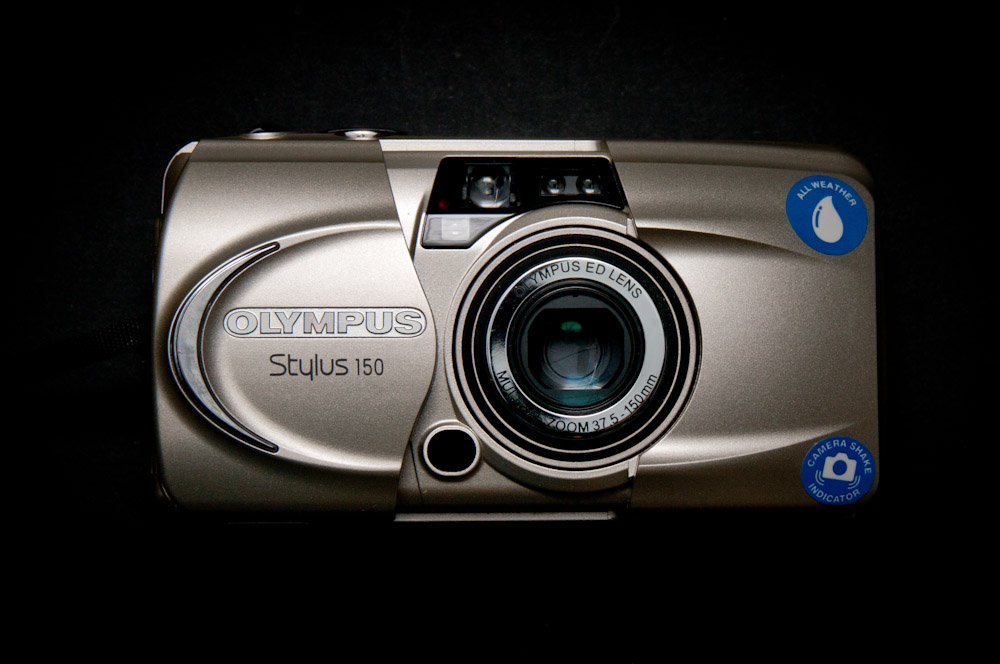
It’s a very different proposition comparing film cameras to each other vs digital cameras because the major differences are always the lenses, focus and the exposure system the sensors (film) is the same. With digital there are many more things that differentiate cameras. Because of this it’s almost easier to speak of certain cameras as a group. The group that the Olympus stylus 150 falls into is that of the auto exposure zoom compact. This was the end of the line for film point and shoot cameras with their slow lenses requiring fast film and with the often poor results people got from camera shake at the telephoto end, it was inevitable that camera companies turned their attention fully towards digital capture. These cameras after all were what people were comparing to digital cameras when deciding which to buy at the beginning of the millennium.
Other cameras in this list are: Canon z180u (2004), Nikon light touch zoom 150 ED (2002),Pentax Espio 140v (2002) Samsung Evoka 140 (?) ,Ricoh RZ3000, (1998)
These last kick at the film canister cameras are destined to mostly disappear, they aren’t particularly collectible other than as a marker in camera history and they don’t produce results that stand out.
The Olympus Stylus 150 lens is 37.5mm to 150mm f5.1 to 13.3, 8 elements in 7 groups with both ED and aspherical elements. Autofocus is 11 point and is designed to accommodate off center subject framing.
3 comments | tags: film, olympus, Stylus | posted in Cameras, Photography
Mar
25
2013
If you have visited my blog before you may know I like to shoot film. I like the look I get and I enjoy the chance to use all the different old cameras that are available. On this day I decided to take the Pentax Spotmatic II with a selection of Takumar lenses. The added benefit was that with an adapter these lenses fit on my Pentax K-7 DSLR as well. Despite the lens sharing weight savings between the two cameras the total weight in my camera backpack was significant, making me a bit top-heavy. I wasn’t alone but fellow photographer Duncan Turner had his gear more evenly distributed on his bike. Yes we rode bikes, what a great way to get around when taking pictures. You can cover more ground than when walking yet you are still able to see as much or more around you. Here are some selected images from the first of two rolls I shot through the Spotmatic.
3 comments | posted in Cameras, Photography, Uncategorized
Mar
23
2013

Hello 1983, keep the hair we will keep the cameras. Nikon refers to this camera as the “Pikaichi” which apparently translates as “Top notch” and they were quite proud of it. The lens is unique in that it has a focal length of 35mm yet is a Sonnar design which is more commonly associated with 50mm and above.

It seems to be a pretty good performing lens, unfortunately I used the Cherry wide angle and telephoto adapters on most of the pictures so the true performance is somewhat obscured.  The nice thing about this adapter set though is that they come with lenses for the viewfinder so you get the proper field of view but putting them on and taking them off is cumbersome. So what I like about this camera is the little focus distance scale in the reasonably large viewfinder and the feel of the camera. While not a light camera it fits nicely in one hand with its front grip and textured pad for your thumb. See the early 1980’s weren’t all bad.
The nice thing about this adapter set though is that they come with lenses for the viewfinder so you get the proper field of view but putting them on and taking them off is cumbersome. So what I like about this camera is the little focus distance scale in the reasonably large viewfinder and the feel of the camera. While not a light camera it fits nicely in one hand with its front grip and textured pad for your thumb. See the early 1980’s weren’t all bad.
4 comments | tags: camera, Nikon | posted in Cameras, Photography, Uncategorized
Mar
21
2013

I chose this lens from my parts bin because it was a complete package including a helical focus system, unfortunately I don’t know what camera it came off but it appears to be a 40mm f2.8. That 40mm when converted to a full frame equivelent is 220mm. Once I figured out the distance it needed to be placed from the sensor I mounted it on the end of a piece of ABS tubing which also attached to a modified Q to C-mount adapter I had purchased on the internet. Initial testing was done with no aperture, it was wide open. The resulting images were soft and lacked contrast as you can see with these following images.
My next step was to line the inside of the lens with black velvet paper to keep down the internal reflections and create a fixed aperture to try to improve the lens performance. These changes had a dramatic impact on image quality.
But I wasn’t quite done. I made a new aperture that was a bit smaller and did some more testing. This is the state that it is at right now.
I was likely 100 feet away from the rebar in the one picture and you can see that the bridge, hundreds more feet away, was also in focus. That isn’t always a desirable quality especially if you want to use selective focus to separate different planes in an image but on the other hand this is a feat you can’t easily accomplish with a large sensor camera if it is what you want. And the lens is very small I might add.

A final note here is a comparison 100% crop from the Nikon P7000 at full zoom (200mm equivalent) vs the Q homebrew (220mm equivelent). The Q is on the left.
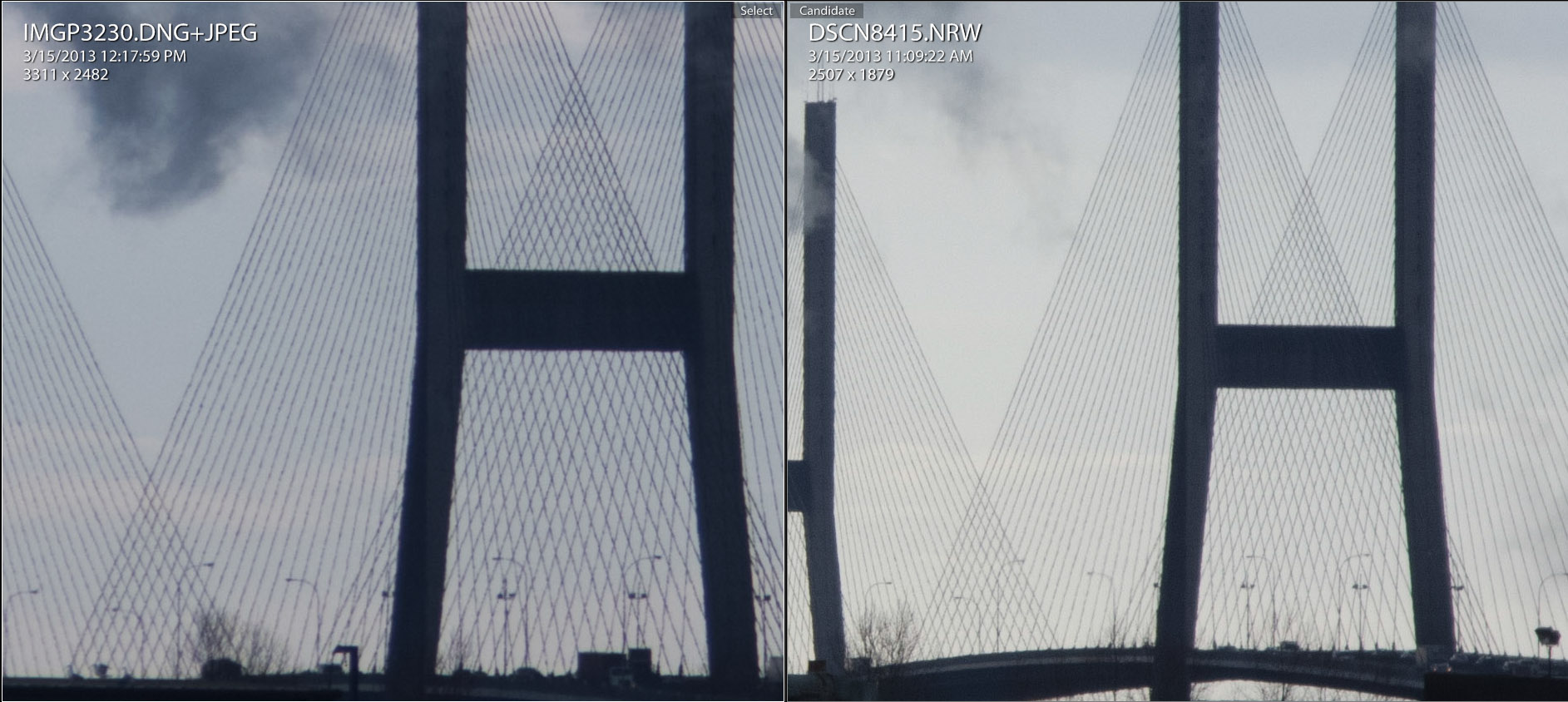
3 comments | tags: lenses, Pentax, Q | posted in Cameras, Photography
Mar
18
2013

Forged in the fires of Mordor this camera rules them all…oops apparently this isn’t that kind of elfin camera and its plastic would melt quicker than butter on a hobbits scone. What it is though is diminutive and equipped with a nice 26mm f2.8 prime lens. This hobbit sized APS camera is small enough that you can even forget it’s in a pocket. Like most cameras of its time control only goes as far as turning the flash off and I’ve discovered it doesn’t focus well when you put it up against a chain link fence ( there are two examples of that in the pictures they should be easy to spot). It’s almost hard to say if the lens is better than the zoom of the original Elph because APS film is just awful, it is the great equalizer. The specifications for the lens though are 32.5mm focal length equivalent in terms of 35mm film and 4 elements in 4 groups one of them an aspherical element so I’m going to say its better than the film would suggest.
2 comments | tags: APS, Canon, film | posted in Cameras, Photography
Mar
9
2013
In response to the uproar over Hasselblads Lunar rebranding of the Sony Nex7 I thought i would point out that this sort of thing has been going on for a long time. Many cameras have been released under different names. It’s been mentioned on the Internet how many parts the Minolta Freedom Escort and the Leica Mini share but a visual comparison is always nice. (Update the Olympus AF Mini is part of this litter)


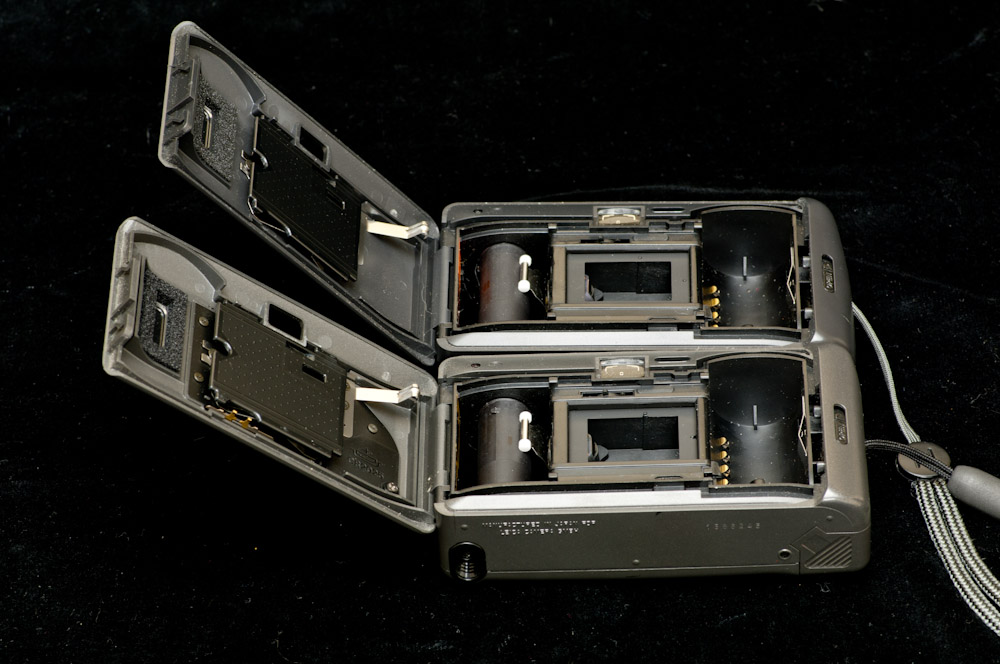
Update this post has been sitting written and ready to post for over six months it just got pushed to the back. I could have removed the no longer topical reference to the Hasselblad but that camera is still funny.

Wait it’s triplets! As Drewboom pointed out to me the Olympus Trip AF Mini was seperated from these two at birth and it definetely shares major parts with its siblings.

7 comments | tags: Leica, Minolta | posted in Cameras, Photography

